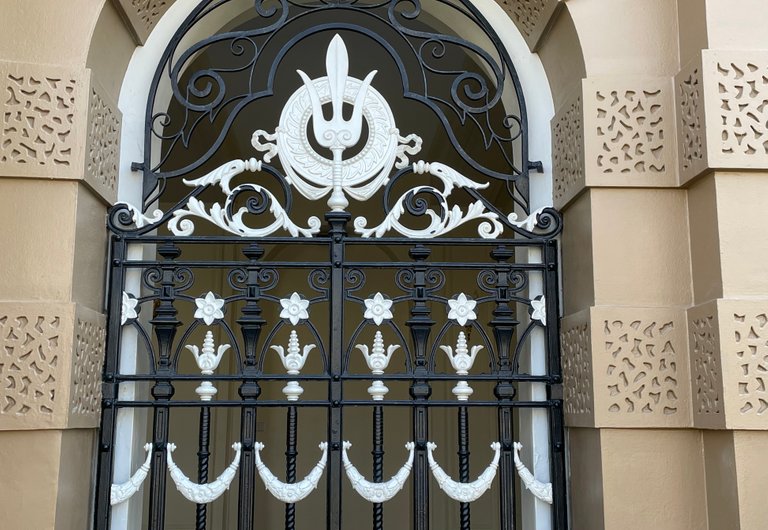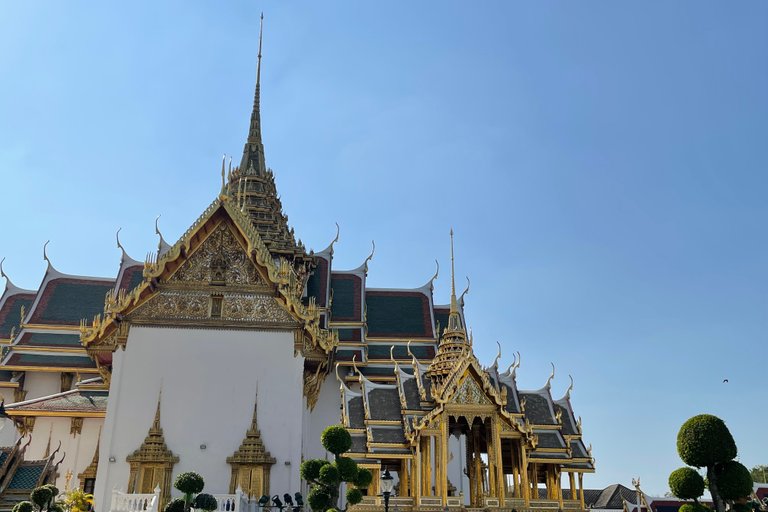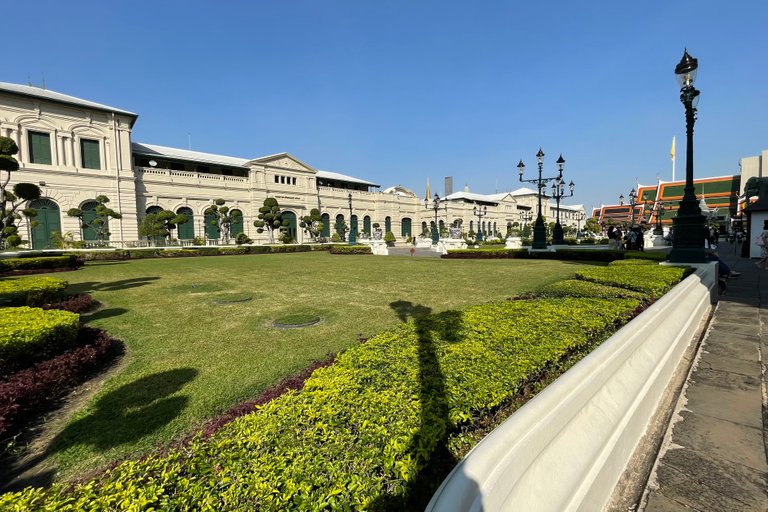From time to time, I would get a sudden urge to pay a visit to the Grand Palace and the Wat Phra Kaew (Temple of the Emerald Buddha). I rarely travelled all the way to the Grand Palace as it would take me almost an hour to get there and the prospect of tourist crowds did change my mind often. I was used to the quiet and peaceful atmosphere of that place as I often accompanied my uncle there on Sundays. Now that my dear uncle had passed away a few years ago, I would try to find the time to walk around the Grand Palace in his remembrance.

I was the only grandchild of my Chinese family side who was partly raised by my Chinese relatives so I could understand Chinese language. These simple elderly relatives were amazingly noisy and kind, but my uncle was quite different as he was very religious and liked to go temples a lot. I probably got this interest in spiritual matters and religious ceremonies from him as a kid. The serene and quiet atmosphere of the place he took me had stayed embedded in my memory forever.

Whenever I missed my uncle and felt grateful to his kindness and beneficial influence on me, I would have a quiet walk around the Grand Palace. I could recall how we would get there on his old Vespa, the weather was always pleasant in those days with no traffic jam or air pollution. He would pay respect to all the shrines and statues around the place. I learned to light candles and incense as a kid, including the importance of having jasmine garlands.

I wished I had looked him up when he became older and got sick. He moved to a new house with his daughter, this house was outside Bangkok. So, I couldn’t contact him for several years. At least another uncle managed to get in touch with me to tell me about my favourite uncle’s funeral. The Temple and Grand Palace gave me the chance to reminisce about my childhood and good old days with my dear uncle.


I did a post about the Temple of the Emerald Buddha or Wat Phra Kaew here. So, I just guided you through the Grand Palace which we had to pass on the way to exit the Grand Palace. I was not very interested in the Grand Palace many years ago as I couldn’t relate to such grand building with strange architecture to me. I couldn’t understand why the palace wasn’t built with completely Thai architectural design.


After some haphazard reading and reflection, I realised that I was heavily influenced of the work of a well known social critic in those days. He wrote several articles and books on Thai history and had established himself as a respectable intellectual with old English education background. He turned out to be a staunch sympathiser of those who instigated a coup and overthrew the monarchy. He wrote several articles and books in defense of the coup and often made jokes about the monarchy. He would never directly attack the monarchy as that would risk a court proceeding and probably an arrest. But he did sow the seeds of disrespect, doubt and dislike towards the monarchy.

I later discovered about the background of this popular intellectual and social critic through my own research and investigative paper by an elderly writer (who was very knowledgeable about French history and the revolution, including the recruitment and indoctrination of young Thai scholars in European universities. So, I stumbled upon a movement or long project of slowly changing our traditional forms of governance into progressive Western democratic model.


This new form of colonisation was incredibly subtle and difficult to comprehend at first. Only when I gathered all the important pieces of the puzzles together, the complex patterns of disconnected actors and events suddenly formed a big picture of long term vision of how to divide and rule the country. Very few people seemed to be aware of this obnoxious strategy, I could see some sign that those dealing with with national security did know about this. It startled me that those officials couldn’t really affect major changes as the politicians were the decision makers. Who would be able to know what secret agreements politicians had made with other powerful agents?


So, the architectural design reflected the arduous effort of several Siamese Kings to prevent the country from being colonised by the French and British Empire. When King Rama I established Bangkok as a new capital city of Siam, the country was damaged by years of intense fighting with the Burmese. The old Ayuttaya was completely devastated and burnt down during the Burmese invasion. All the gold decorated on the roofs of temples were melted down; it took seven days of burning to melt all the gold from temples to be collected. The golden roof at the famous roof of the famous Burmese temple was from Ayuttaya. That’s why I could never visited Burma for fear of past life regression or psychic feedbacks which could disorient me from immediate reality.


The old palace built by King Taksin on the Thonburi side of the river was very modest, small and simple. King Taksin was extraordinary as he could gather his own troops, recruit villagers, built over a hundred boats in order to defeat the Burmese troops and gain independence in only nine months. But his life was short and complicated by some hidden intrigue which involved rumours and conflicting historical evidence. His best friend became King Rama I who established a new dynasty with Bangkok as the new center of administrative power.


His palace was built from wood and salvaged bricks from Ayuttaya. The country was financially broke and her population was recovering from the wars with the Burmese. So, it took years for the palace to evolve and became as the Grand Palace. In the old days, it was just like a new village fulled of disheveled people trying to start a new life. The long peaceful period of having no military aggressions from old rivals gave the people a chance to establish a new era of stability and prosperity. Trading with foreign visitors contributed to increasing wealth and better living conditions.


King Rama III was very famous for his business acumen. The King made so much profits from his own trading projects that there were bags of gold coins from Mexico, Spain and other countries. The King was probably psychic as he stated that these gold coins would be used to pay for ransom of Siam one day. These hundreds of bags full of gold coins were in red bags hidden in a vault in the Grand Palace. But I could never find out the location of that gold vault. Some friend had told me to notice the deep trails of wheel barrows used to transpot hundreds of gold bags in front of the building. I regretted that I never took the offer for a private tour of the Grand Palace years ago.

Each Siamese King tried to remodel and renovate the Grand Palace as s symbol of a refined and traditional cultural values with modern and progressive adaptability. That’s why the architecture was a mixture of Thai and European structural design. The Grand Palace had to look grand and full of opulence including good taste and historical connections. King Rama IV had toured Europe twice and sent many of his sons to study in France, Germany, England and Russia. So, the designs of the Palace would be embellished with lots of European designs.

On the other hand, King Rama III had very close commercial links with China. So, we could see the Chinese style roof and stone sculptures dotted around the Grand Palace. The bonsai trees and ceramic potteries and pot plants were the legacy of Chinese cultural influences during this King’s reign. The reign of King Rama IV had been mostly occupied with how to survive the new wave of aggressive colonisation which horribly spread like disease in South East Asia. Fortunately the King had several foreigners who took positions in civil administration and assisted in the early phase of reform in Siam.


The reign of King Rama V saw more drastic changes and modernisation in many aspects of society, technology, education, infrastructure, transportation and the need to westernise local culture. King RamaV shocked his royal entourage to stand up straight while talking to him. It would need a short essay to describe the foresight and wisdom of this King in trying to prepare people for a new world of colonialism.

Several European engineers and architects were involved in transforming Bangkok into beautiful modern city with boulevards, fountains, western looking buildings and palaces. Some English lawyers, Italian artist (sculptor), and several foreigners were engaged in consultations on taxation systems, translation of laws, irrigation, town planning, including the establishment of the first Art University. Most Siamese people didn’t understand why the King went on a whirlwind of construction of buildings with Western architecture and very wide roads which seemed so unnecessary and wasteful. But these big buildings have become major government departments nowadays while all those wide roads could hardly cope with traffic jams in Bangkok.

Major changes and renovations of the Grand Palace took place during King Rama IX reign. These improvements were heavily criticised by some social critics and intellectuals. The effort to sabotage the monarchy and to instigate another revolution by popular uprising had been ongoing during the last thirty years. So, the Grand Palace with its strange European gates and lion sculptures represented a phase in our history of maintaining the country’ sovereignty. Whereever I looked, I saw the painful struggles and anxieties of our ancestors. They wrecked their brains, lives and wealth for the well being and independence of future generations.


There were hidden scars of painful surrender of land and wealth to demanding aggressors in exchange for peaceful settlement of disputes. The threat of being colonised was palpable as French war ships were dispatched to watch over Chi-Chang island where most royalties were enjoying their holiday. The negotiations prevented the French from taking all these royal households as hostages. The French colonisers got the paybacks of their bad karma as they were defeated by the Vietnamese independent movement. It’s a shame that people weren’t allow to learn the real history so that history won’t be allowed to repeat in other manifestations.


I left the Grand Palace with a heavy heart as I knew the country would become a stage for another major attempt of neo-colonialisation. Most politicians were the product of demented education systems bio and inculcated value systems. They were so inept and lack the depth of knowledge or wisdom of our ancestors. They unwitting politicians did facilitate abd intensify the pace towards sHocial upheavals in the near future. Dark clouds are gathering on the horizon. There have been signs and warnings from retired intelligence officers about social unrest later this year. Some kind of coloured revolution has been in the making since last year. I do hope the bad karma would catch up with these treacherous people and instigators very soon. I have to continue with my exercise in mindfulness and counting my blessings in this reckless world.



Wishing you peace, good health and prosperity.
Stay strong and cheerful.
#marketfriday hosted by @dswigle.
Discord Server.This post has been manually curated by @bhattg from Indiaunited community. Join us on our
Do you know that you can earn a passive income by delegating to @indiaunited. We share more than 100 % of the curation rewards with the delegators in the form of IUC tokens. HP delegators and IUC token holders also get upto 20% additional vote weight.
Here are some handy links for delegations: 100HP, 250HP, 500HP, 1000HP.
100% of the rewards from this comment goes to the curator for their manual curation efforts. Please encourage the curator @bhattg by upvoting this comment and support the community by voting the posts made by @indiaunited.
Thank you very much for your kind support.
Have a nice day!